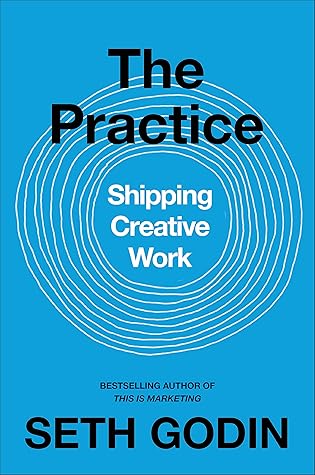More on this book
Community
Kindle Notes & Highlights
When you choose to produce creative work, you’re solving a problem. Not just for you, but for those who will encounter what you’ve made. By putting yourself on the hook, you’re performing a generous act. You are sharing insight and love and magic. And the more it spreads, the more it’s worth to all of those who are lucky enough to experience your contribution. Art is something we get to do for other people.
Our work is about throwing. The catching can take care of itself.
For the important work, the instructions are always insufficient. For the work we’d like to do, the reward comes from the fact that there is no guarantee, that the path isn’t well lit, that we cannot possibly be sure it’s going to work. It’s about throwing, not catching. Starting, not finishing. Improving, not being perfect.
Your work is too important to be left to how you feel today. On the other hand, committing to an action can change how we feel. If we act as though we trust the process and do the work, then the feelings will follow. Waiting for a feeling is a luxury we don’t have time for.
If we condition ourselves to work without flow, it’s more likely to arrive. It all comes back to trusting our self to create the change we seek. We don’t agree to do that after flow arrives. We do the work, whether we feel like it or not, and then, without warning, flow can arise.
The practice has nothing at all to do with being sure the work is going to be successful. That’s a trap. The guarantee requires industrial sameness, recipes that have been tested, and most of all, the fungible labor of the disrespected laborer. If anyone can do it, then we’ll just hire anyone.
The very nature of innovation is to act as if—to act as if you’re on to something, as if it’s going to work, as if you have a right to be here. Along the way, you can discover what doesn’t work on your way to finding out what does.
For art to be generous it must change the recipient. If it doesn’t, it’s not working (yet). But realizing it’s not working is an opportunity to make it better. The practice is agnostic about the outcome. The practice remains, regardless of the outcome.
It’s tempting to prepare yourself against inevitable failure. Perhaps by becoming a pessimist and a cynic, you could spread your suffering out over time. If your expectations are low, you won’t be disappointed. Too often, though, that suffering becomes a self-fulfilling prophecy, a habit we hold on to that infects our work.
If you’re on a journey but it’s rarely causing a spark, you probably need to make better work. Braver work. Work with more empathy. Once you learn to see, you can learn to improve your craft. Combined with your commitment to the practice, it’s inevitable you’ll produce an impact. If you care enough.
Elsa von Freytag-Loringhoven, the original punk artist, and also a baroness, created a work of art that caused a sensation. She bought a ceramic urinal at an industrial supply house and her friend Marcel Duchamp entered it into an art exhibit. “Fountain” changed the world of art forever.
Your practice is a journey, and it takes you to a room. A room with different rules, different expectations, different challenges. You know when you’re in that room. You’ve probably been there before. Salto mortale, the dangerous leap, that feeling in your stomach when you’re in thin air, neither here nor there. Some people avoid this feeling. That’s why they need a recipe and want reassurance that the work they do will pay off.
It’s insulting to call a professional talented. She’s skilled, first and foremost. Many people have talent, but only a few care enough to show up fully, to earn their skill. Skill is rarer than talent. Skill is earned. Skill is available to anyone who cares enough.
Everyone who creates feels resistance. Everyone who is seriously engaged in the deep effort of inventing and shipping original work feels the fear. That’s not the question. The question is: where do you put the fear?
Good needs to be defined before you begin. What’s it for and who’s it for? If it achieves its mission, then it’s good. If it doesn’t, then either you were unlucky, incorrect, or perhaps, what you created didn’t match what you set out to do. And yes, there’s a huge gap between “good” and “as good as it could be.” It’s likely we’ll never bridge that gap.
Of course, at first, all work is lousy. At first, the work can’t be any good—not for you and not for Hemingway. But if you’re the steam shovel that keeps working at it, bit by bit, you make progress, the work gets done, and more people are touched. There’s plenty of time to make it better later. Right now, your job is to make it.
Find this cohort with intent. Don’t wait for it to happen to you. You don’t need to be picked—you can simply organize a cohort of fellow artists who will encourage themselves.
When we require outcomes as proof of our worth, we become brittle, unable to persist in the face of inevitable failure on our way to making a contribution.
You have everything you need to make magic. You always have. Go make a ruckus. The magic is that there is no magic. Start where you are. Don’t stop.


